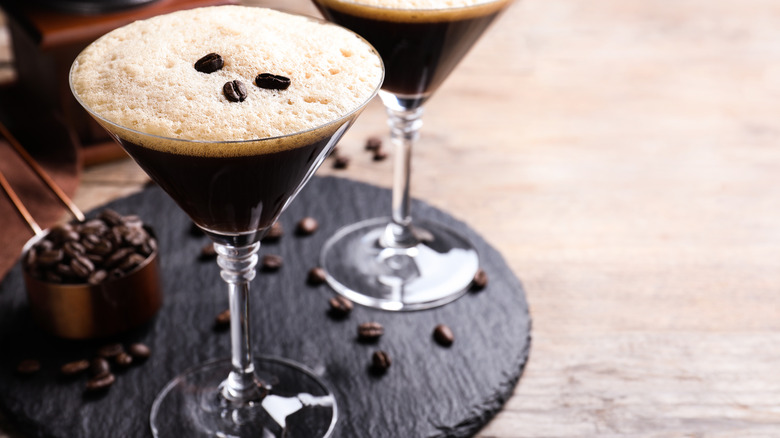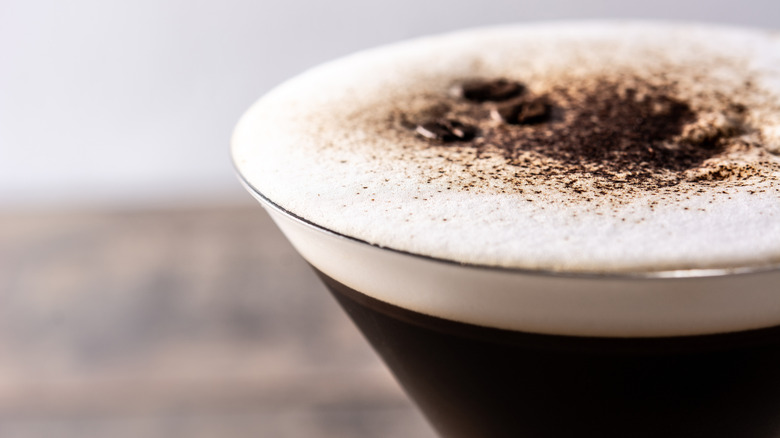Why You Should Never Make An Espresso Martini In Advance
If you appreciate the finer things in life, you might like to enjoy a fancy cocktail or a nice espresso once in a while. And while these beverages are certainly pleasant on their own, the classic espresso martini combines these two delicacies into one delightfully delicious, creamy, caffeinated cocktail unlike any other.
The first espresso martini was mixed by Dick Bradsell, a legendary bartender who created the concoction on the fly after a famous young model walked into Fred's Club, the bar where he was working, in 1983, according to Diageo Bar Academy. The model asked Bradsell to whip up a beverage that would wake her up, and he quickly obliged. Bradsell grabbed the coffee liqueur, mixed it with vodka and fresh espresso to deliver that extra kick, and added sugar for sweetness. The new drink, which Bradsell named The Vodka Espresso, was an instant classic. Although it has gone by other names, including the Pharmaceutical Stimulant, the espresso martini has been pleasing palates with its unique blend of smooth liquor, strong coffee, and sweetness ever since.
Part of the martini's appeal is its foamy finish
Because an espresso martini doesn't require many ingredients, it can be a great way to add a touch of flair to a gathering or special occasion without much fuss. To mix up an espresso martini, you only need a few items: vodka, coffee liquor, fresh espresso, sugar syrup, and three coffee beans for garnish, as well ice, a cocktail shaker, and a strainer — all pretty standard fare for even your most basic of home bars, according to Taste Cocktails.
However, while it may be simple to make, there are still some important rules to follow to ensure the beverage tastes its best. And perhaps the number one rule? Mix your espresso martini on the spot, made to order, much like Bradsell did when he founded the creation. Gail Simmons, a judge on Top Chef and author of the "Bringing It Home" cookbook, explains that the "bubbly, festive wave" of foam that sits atop the espresso martini is a large part of its allure, according to Yahoo Life. However, that foam, an outcome of the ingredients being combined and shaken, fades away after a period of time, making the espresso martini less appealing, both to the taste buds and the eye. Therefore, the best espresso martini is one that is consumed as soon as the cocktail has been shaken and poured.
Crafting the perfect espresso martini
While few things beat a fresh espresso martini, there are other valuable tips to keep in mind to ensure you craft a quality beverage. Using high-quality ingredients is the key to really elevating the drink. Terry Cashman, a London-based bartender at Sweet & Chilli, warns mixologists not to be too heavy-handed with the sugar. While a touch of sweetness is essential to the espresso martini, "not everybody likes sugar in their coffee." Instead, Cashman recommends adjusting the sweetness profile to match how consumers take their coffee. If they prefer a stronger-tasting cup, then let the espresso shine, but those who like a sweet morning brew might want a little extra sugar syrup, according to Diageo Bar Academy.
And, of course, don't forget to garnish with three espresso beans atop the foam. Although these beans may or may not be consumed, they are the cocktail's signature trademark. According to Taste Cocktails, the three-bean garnish comes from an Italian tradition of serving Sambuca with beans, each one representing health, wealth, and happiness for the drinker. As well as being pleasing to the eye, the espresso beans also add an extra kick of enticing coffee aroma, making them the perfect finishing touch for this indulgent cocktail.


